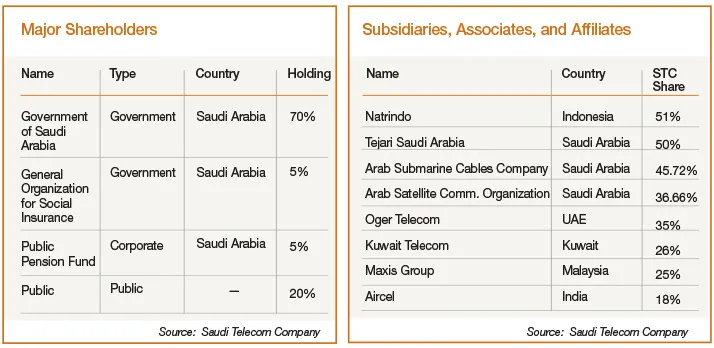If a well-establishd industry leader holds a seemingly impenetrable 80 percent market share, why would it invest the vast resources necessary to introduce not just one, but two comprehensive loyalty programs? In the case of Saudi Telecom Company (STC) maintaining its leadership position in the face of new competitors, changing market demographics, and increasing customer expectations was the primary motivator.
With a customer base of about 23 million subscribers, STC is the eighth-largest telecom company globally. STC executives realized that retaining those millions required understanding them, and thus better responding to their needs. They also understood the unique ability of customer loyalty programs to help deliver on this by helping the company to treat different customers differently. Inspired by the successes of other enterprises across industries have in using loyalty programs to help increase customer satisfaction, reduce churn, and create an emotional link with customers STC examined the benefits of launching its own loyalty initiative. STC executives expected that it would provide a definitive competitive advantage in what is a highly price-sensitive business.
In fact, the telecom behemoth launched not one, but two loyalty programs: one to serve high-value, postpaid customers, called Al Tamayoz; the other to serve the majority of its customers, both prepaid and postpaid, called Qitaf.
STC analyzes postpaid customer spending annually. It then segments customers based on their average monthly bill. High-value postpaid customers are welcomed into the Al Tamayoz loyalty program for the following year regardless of any changes in their behavior. The Al Tamayoz program comprises three tiers—Diamond Group, Gold Group, and Silver Group—based on average monthly spending. Al Tamayoz members receive myraid privileges and benefits, including complimentary sign up, dedicated customer care, special treatment at STC outlets, and the flexibility to increase their credit limit, as well as participation in a free trial whenever STC launches any new products and services.
Qitaf, on the other hand, is a points-based loyalty program for both prepaid and postpaid STC customers that rewards spending. Subscribers earn points for every $2.50 spent, as well as for subscribing to specific services, usage, and timely payment. They can redeem those points for such services as free calling minutes or text messaging, or for shopping vouchers they can redeem for partners’ goods and services across nearly 20 categories, including grocery stores, gas stations, clothing, home appliances, electronics, and travel.
We will focus on Qitaf as it is an extraordinary example from an unexpected location for enhancing the customer experience by leveraging a loyalty program.
Qitaf enables its members to receive tailored services, as well as increasing the perceived value of STC and its services to its customers. Furthermore, with its vast network of points redemption partners, members enjoy a shopping companion that helps them when they need it.
Today there are 7 million prepaid GSM and 4 million postpaid GSM customers enrolled in the highly popular Qitaf program, which currently has an annual growth rate of more than 10 percent. Additionally, more than 3.5 million landline customers are currently enrolled in Qitaf. STC has awarded about 7 billion Qitaf points since the program’s launch. Landline and postpaid customers have earned about 70 percent of those points, while prepaid customers have earned about 30 percent. Customers actively redeem points for the various vouchers available.
The vouchers continue to grow in popularity; STC has issued more than 60,000 since launching the program. STC executives feel the high redemption rates among landline and postpaid customers, where the majority of the points are earned—in other words, on relatively non-volatile services—confirm the success of the existing the customer retention strategy, as well as provide evidence that supports maintaining and growing the program. Qitaf’s popularity is evident in customers’ engagement (i.e. points accrual and redemption) with the program.
The secret of Qitaf’s success
Integral to the success of the Qitaf loyalty program was a set of specific, predefined targets that included partner acquisition and various programs.
Targets for the partnership network include:
- Customer proposition metrics: KPIs that reflect the offered value to the market by each potential partner, for example industry rating, average purchase value, brand value
- Coverage metrics: these include geographical coverage and number of stores
- Financials: measures related to the financial stability of the partner company, as well as any discount rates provided
- Intra-organizational metrics: cooperation, honoring the contract, tenure, and contributions to Qitaf awareness programs
Many of the programs increased in sophistication over time. For example, one basic program launched shortly after Qitaf’s introduction was a Quick Win Campaign that promoted a specific handset. Later STC created “earn or burn” partnerships, whereby customers in the Qitaf program can use points at businesses like a car rental agency and earn them at other establishments, like a hotel. Next was to introduce Exchange of Points partners, like airlines, in which customers can earn and burn points interchangeably. Then STC joined coalition loyalty programs, including Airmiles Middle East and TII (The International Investor). As the Qitaf program evolved, STC also introduced such benefits as rewarding customers for each year they remain an STC customer and offering a cobranded credit card with one of the major financial institutions of the KSA.

STC executives understand that with a wide variety of services available from several telecommunications providers and changes in customer preferences over time, being complacent will most certainly lead to a decrease in customer loyalty. Top management at STC views Qitaf as a key mechanism for increasing retention and protecting market share, and so is fully committed to supporting Qitaf’s continued evolution.
Working with Peppers & Rogers Group, STC is enhancing the Qitaf program based on meeting its customers’ evolving needs. Currently, for example, STC is moving from sending redemption vouchers via mail to sending them via email—a cost reduction to the company that improves the customer experience because the vouchers arrive sooner. This evolution will eventually lead to providing e-vouchers via email, SMS, or MMS that can be redeemed at partner locations using POS devices. Additionally, the company plans to use RFID technologies and location-based services to improve customers’ redemption and partner experiences.
STC also continues to ensure that the Qitaf program benefits its customers, partners, and the company itself. For example, Qitaf provides partners with the ability to conduct exclusive promotions; delivers customer information and insight programs, demographics, and redemption information; and gives partners access to a pool of more than 10 million subscribers in Saudi Arabia. Similarly, partners provide STC’s Qitaf program with vouchers (and a percentage of the voucher value), as well as the ability for Qitaf customers to redeem their vouchers for partners’ products and services.
Customer communication is also crucial to the long-term success of the program. This is the case not only to drive awareness, but also to remind customers that their vouchers are redeemable for STC’s Qitaf points versus thinking the vouchers are directly from the partner. This is important for the future point accrual and redemption. Consequently, STC markets and advertises throughout the year, often linking promotions and events with holidays, sporting events, seasonal activities, and the like. Customized campaigns target different micro-segments to stimulate repetitive purchase behavior, as well as positive word of mouth through peers. Campaigns include “bring your friend and earn points as they spend” and gift packages for higher-value segments that can be sent to customers’ loved ones.
Qitaf’s success is transforming the program into an expertise center for STC’s loyalty and retention activities. STC is planning to promote Qitaf’s business expertise not only inside the company, but also externally, by marketing its expertise in loyalty program management. It’s planning to productize Qitaf’s business rules and acumen and make them available to other organizations.

















